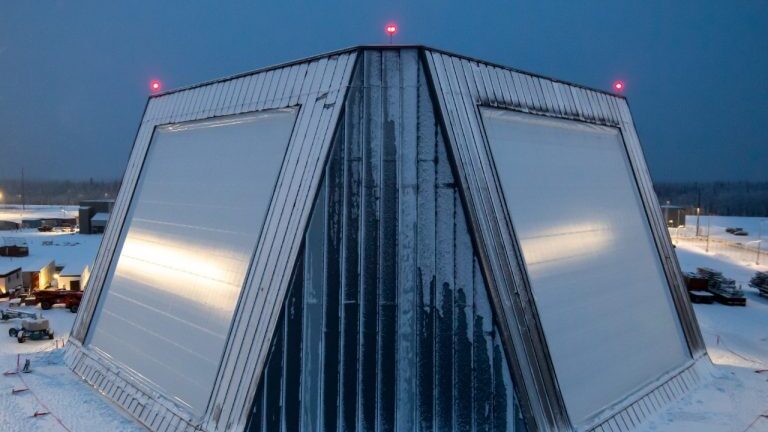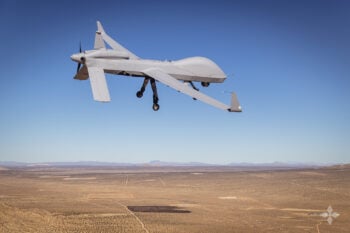
Long Range Discrimination Radar (LRDR) is being tested by Northern Command at the Clear Space Force Station in Alaska. (Photo: Missile Defense Agency)
WASHINGTON — The Missile Defense Agency failed to meet all of its baseline goals for delivering and testing systems last year, according to a new report by Congress’s watchdog agency — and as a result may end up accepting contractor delivery of one new high-priority system, the Long Range Discrimination Radar (LRDR), before its capability has been verified.
Released today, the “Missile Defense: Annual Goals Unmet for Deliveries and Testing” report is the 20th annual oversight review by the Government Accountability Office of MDA’s performance since the agency’s establishment by the Department of Defense in 2002. During that time, according to GAO, the agency has spent more than $194 billion, including $10.4 billion in fiscal 2022. Congress appropriated $10.5 billion for MDA in FY23, and the agency asked for $10.9 billion in its FY24 budget request.
“Over this time, missile threats from foreign adversaries have evolved, and MDA has faced persistent challenges as it attempts to keep pace. GAO has reported that MDA has not met the annual goals it sets for itself to deliver hardware and test its capabilities,” the report says. And yet as of last June, the report adds, 23 of GAO’s recommendations for helping the agency improve performance have gone unmet.
In the report, the watchdog office looked at MDA program plans and performance against the agency’s baseline goals from June 2022 to May 2023 for interceptor and radar upgrade deliveries to the missile defense systems now operated by the military services, as well as ground, flight and cybersecurity testing.
The upshot, according to the GAO report: “In 2022, MDA continued to deliver interceptors and radar upgrades to operational commanders, including those that were expected to be delivered in prior years, but it did not meet its annual goals. As a result, the warfighter has less fielded capability than planned.”
Further, the agency did “not complete its fiscal year 2022 flight, ground, and cyber baseline test program, consistent with prior years.”
The report did not include a response from MDA, and a spokesperson declined to comment to Breaking Defense.
Interceptors
GAO found that MDA “partially met” its goals for interceptor deliveries. It delivered all 89 planned interceptors, including those backlogged from prior years, for the Terminal High Altitude Area Defense program, and managed to deliver both Ground Based Interceptors planned for 2022 by early 2023. The agency missed its goals, however, for both the Aegis Ballistic Missile Defense Standard Missile (SM)-3 Block IB and the SM-3 Block IIA.
Radar Upgrades
While MDA “made progress on upgrades to two Early Warning Radars and the construction of a new Long Range Discrimination Radar,” GAO found that “technical challenges and pandemic-related delays have continued” to set the agency’s sensor efforts behind schedule.
For example, the report noted, “neither the Army Navy/Transportable Radar and Surveillance Control Model-2 (AN/TPY-2) or the Sea-Based X-Band Radar (SBX) radar received planned software upgrades originally delayed from fiscal year 2021.”
Testing
“MDA’s inability to conduct all of its planned flight tests has been a long- standing issue,” the report states. GAO provided the following summations of MDA’s 2022 performance against its testing baselines:
- Flight testing: Flight tests use actual hardware to demonstrate or assess system performance. MDA conducted six of nine planned tests, and met objectives in five of those six tests.
- Ground testing: Ground tests use simulations to model capabilities and limitations in a wider variety of potential situations than flight tests. MDA conducted a key ground test—originally planned for fiscal year 2020— intended to support decisions necessary to increase capability to defend the United States. However, MDA conducted three of nine planned ground tests, deleting or delaying the tests not conducted to future fiscal years.
- Cyber testing: Cybersecurity operational assessments evaluate cyber defense capabilities and vulnerabilities. MDA conducted two such tests in fiscal year 2022—about a year later than planned—but scaled back the scope of these tests and delayed five other tests to future years.
LRDR: Testing Delays Raise Risks
In particular, GAO expressed serious concerns about MDA’s failure to keep up with ground and flight testing of the Long Range Discrimination Radar (LRDR).
The radar system was initially fielded at Clear Space Force Station in Alaska in December 2021, but GAO says that “the program continues to experience cost increases and schedule delays” — with the Space Force now not expecting to take final delivery from prime contractor Lockheed Martin before the end of this fiscal year in September.
“The LRDR is at risk of being delivered by the contractor to MDA before the program achieves critical knowledge points or participates in any successful flight tests. As a result, the LRDR’s capability and limitations may not be fully known or verified prior to the government accepting the radar for operational use,” the report explains.
LRDR is one of the top priorities for US Northern Command, with the S-band radar’s primary purpose to distinguish between intercontinental ballistic missiles launched by adversarial nations and decoys or other innocuous objects moving through space. MDA asked for $103.5 million in FY24 for the program.
Assessments of the radar’s ability to acquire and track threat objects planned for 2022 now are being pushed back to “either” FY23 or FY24, the report finds.
“In addition, a delayed flight test designed to operationally assess the LRDR — FTX-26 — is currently planned for the same quarter as the current date by which the contractor plans to deliver LRDR to MDA. Any delays to MDA’s testing schedule in fiscal year 2023 may push FTX-26 to after this delivery is expected to take place. Even if the test is conducted as planned, MDA will have limited time to assess the test’s results and take any necessary actions before LRDR is delivered to the agency. Although MDA officials said FTX-26 is not required to be conducted prior to the contractor’s delivery, a flight test is required prior to operational acceptance of the radar by the U.S. Space Force,” GAO asserts.
Aloha: Fixes ongoing, then Army’s new watercraft prototype is Hawaii bound for testing
“Everything that we can knock off that list we will do in the archipelago…because that allows us to do the tests in the environment that the vessel will operate in ultimately,” said Maj. Gen. Jered Helwig.


























